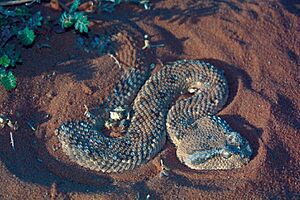Cerastes gasperettii facts for kids
Quick facts for kids Cerastes gasperettiiTemporal range: Pleistocene-recent
|
|
|---|---|
 |
|
| Conservation status | |
| Scientific classification | |
| Genus: |
Cerastes
|
| Species: |
gasperettii
|
 |
|
| Synonyms | |
|
|
The Arabian horned viper, also known as Cerastes gasperettii, is a type of venomous snake. This snake belongs to the Viperidae family, which includes many well-known vipers. It lives in the Arabian Peninsula and areas north of it, like Palestine (region), Iraq, and Iran.
This viper looks a lot like another snake called Cerastes cerastes. However, these two snake species live in different places and do not share the same habitats. Scientists do not recognize any different types or subspecies of the Arabian horned viper.
Contents
What's in a Name?
Why is it Called Gasperettii?
The second part of the snake's scientific name, gasperettii, honors a person named John Gasperetti. He was an American engineer and a herpetologist. A herpetologist is a scientist who studies reptiles and amphibians. John Gasperetti was the one who first collected the original snake specimen that scientists used to describe this species.
How to Identify the Arabian Horned Viper
What Does This Snake Look Like?
The Arabian horned viper usually grows to be about 30 to 60 centimeters (12 to 24 inches) long. This measurement includes its body and tail. The longest one ever recorded was about 85 centimeters (33 inches) long. Female Arabian horned vipers are typically larger than the males.
What Do They Eat?
Hunting for Food
The Arabian horned viper mainly eats rodents, like mice or rats. It also enjoys a meal of insects, especially beetles. Sometimes, it will also hunt and eat lizards.
How Do They Reproduce?
Baby Vipers
The Arabian horned viper reproduces by laying eggs. This means it is an oviparous animal. Many snakes lay eggs, and the young hatch from them later.
Where Do They Live?
Geographic Range of the Arabian Horned Viper
You can find the Arabian horned viper across the Arabian Peninsula. This includes countries like Saudi Arabia, Kuwait, Oman, Qatar, United Arab Emirates, and Yemen.
It also lives in the Arava valley, which is a border area between southern Israel and Jordan. From there, its range extends eastward through Jordan and Iraq. It can be found as far as the Khuzestan Province in southwestern Iran.
Preferred Homes for the Viper
The Arabian horned viper likes to live in deserts and shrublands. These are its natural habitats. It can be found in places that are as high as 1,500 meters (about 4,900 feet) above sea level.
Images for kids





